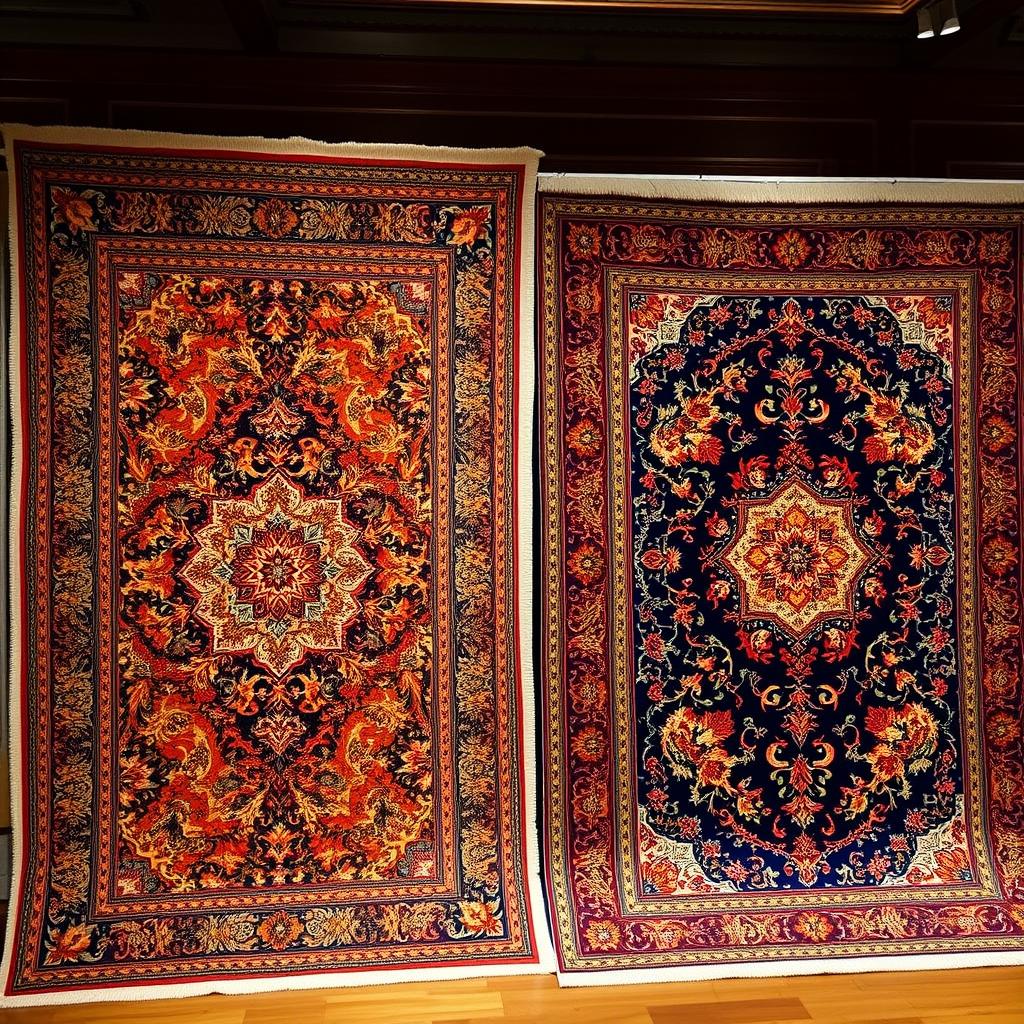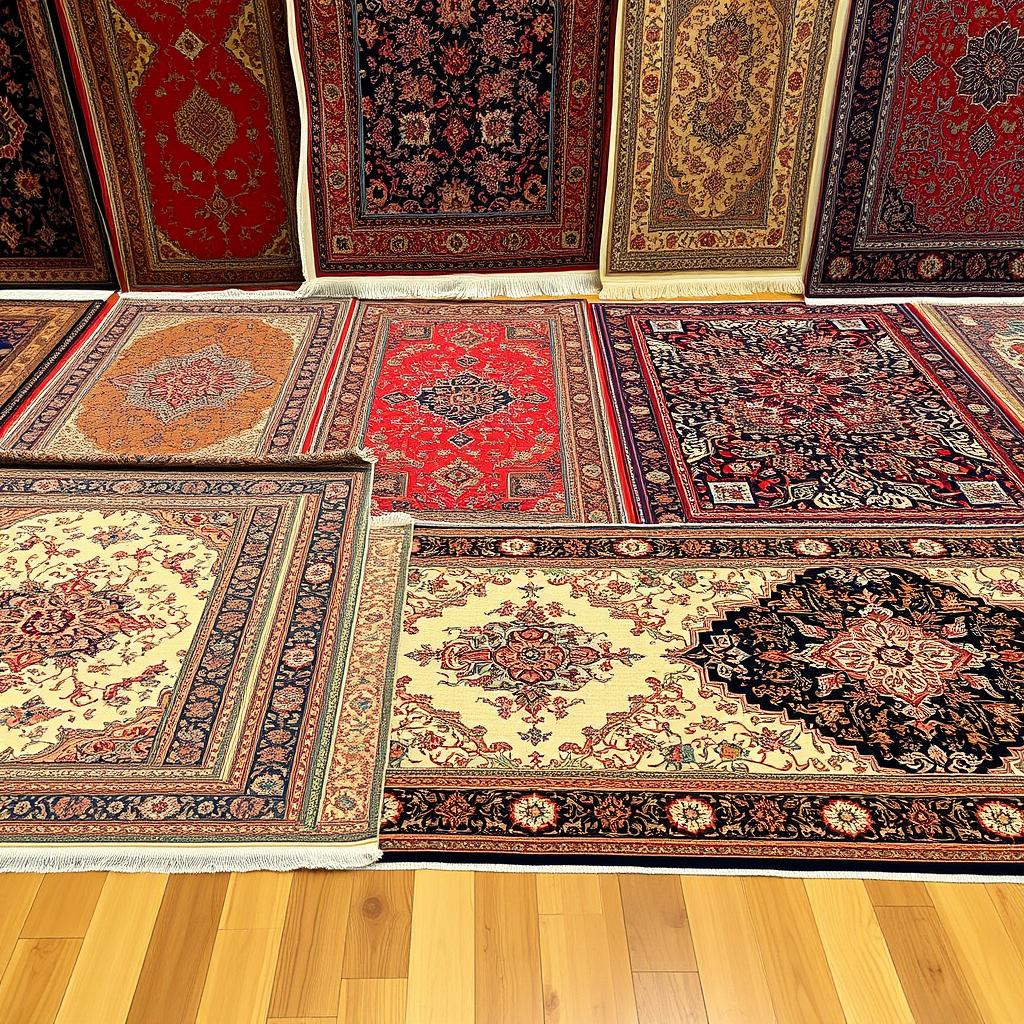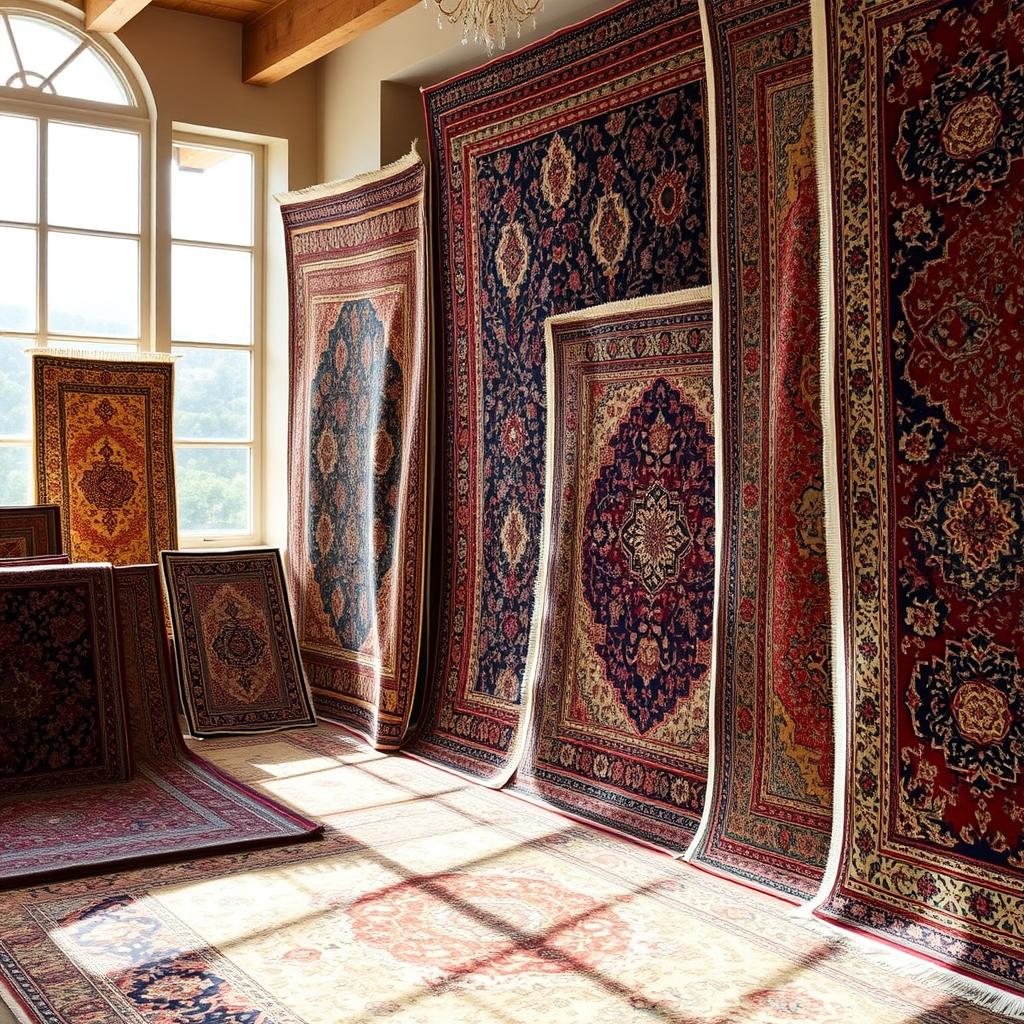Imagine stepping into a world where every thread, knot, and color tells a story. This world is filled with Persian carpets, masterpieces from the East. They have won the hearts of many, including art lovers, interior designers, and history enthusiasts. Each carpet is a unique blend of culture and art. What makes Persian carpets so special? What makes them so sought after around the world? Let’s dive into the world of Persian carpet styles. Here, ancient traditions meet modern touches, creating stunning works of art. From the grand royal court carpets to the rugged tribal and nomadic rugs, we’ll explore it all. This guide will reveal the secrets behind these remarkable handmade textiles.
Click to use Silverigroup personal shopper services
Key Takeaways:
- Discover the rich tapestry of Persian carpet styles, each reflecting a unique regional heritage and artistic expression.
- Explore the intricate materials, dyes, and weaving techniques that give Persian carpets their unrivaled quality and durability.
- Understand the cultural significance of Persian rugs and their enduring influence on global design and art.
- Learn how to identify authentic Persian carpets and appreciate their inherent value as timeless works of art.
- Appreciate the skilled craftsmanship and centuries-old traditions that make Persian carpets some of the most sought-after and valuable textiles in the world.
Understanding Persian Carpet Heritage and Significance
The art of making Persian rugs has a long history. It spans centuries and shows the cultural heritage and skill passed down through generations. These intricate patterns are a key part of Iranian society.
The Historical Evolution of Persian Rug Making
Persian rug making started in ancient Persia, around the 5th century BC. Over time, each region in Iran developed its own style. This shows the creativity and skill of the Iranian people.
Click to buy antique rugs from Silverigroup
Cultural Importance in Iranian Society
Persian carpets are very important in Iranian culture. They symbolize national pride and identity. These rugs are not just for decoration but also carry the country’s rich heritage.
Global Recognition and Value
Persian carpets are known worldwide for their beauty and skill. They are loved by collectors, designers, and art lovers. Their value shows the lasting impact of this ancient art on global culture.
| Region | Characteristic Patterns | Prominent Features |
|---|---|---|
| Tabriz | Floral and garden motifs, intricate designs | Silk and wool, fine knotting, high-quality dyes |
| Isfahan | Geometric patterns, central medallion designs | Silk and wool, dense knotting, vibrant colors |
| Qashqai | Tribal and nomadic designs, bold colors | Wool, coarse knotting, natural dyes |

Types of Persian Carpets: Regional Classifications
The vast and diverse landscapes of Iran have inspired many types of persian carpets. Each region has its own carpet weaving traditions. These reflect the local culture, natural resources, and artistic skills.
The Tabriz rug is famous from the city of Tabriz in northwestern Iran. These carpets are known for their detailed floral designs and bright colors. They are often made for royal courts and high-end clients.
The Gabbeh carpets from the southwestern regions are known for their bold, abstract patterns. They have natural, earthy tones. These rugs are made by nomadic tribes, showing their simple, traditional way of life.
| Regional Style | Distinctive Characteristics | Production Area |
|---|---|---|
| Tabriz Rugs | Intricate floral designs, vibrant colors, exceptional craftsmanship | Tabriz, Northwestern Iran |
| Gabbeh Carpets | Bold, abstract patterns, natural, earthy tones | Southwestern Iran |
| Kashan Carpets | Elegant, symmetrical designs, rich colors, high knot density | Kashan, Central Iran |
| Kerman Rugs | Intricate floral motifs, soft color palettes, fine weaving techniques | Kerman, Southeastern Iran |
Other notable styles include the elegant Kashan carpets from central Iran. They are known for their symmetrical designs and rich colors. The Kerman rugs from the southeastern region are famous for their delicate floral motifs and fine weaving. The variety of types of persian carpets shows Iran’s rich cultural heritage and artistic traditions. Each region adds its own unique touch to the country’s carpet-making legacy.

Materials and Construction Techniques
Handmade Persian rugs are known for their lasting beauty. This is thanks to the careful work of skilled artisans. They use top-quality wool and silk, and special dyeing and weaving methods. Each step shows the deep cultural roots of Iran.
Traditional Wool and Silk Usage
The best Persian carpets start with the right materials. Artisans pick the softest wool from Cachemire. They also use silk for its shine and feel.
Natural Dye Processing Methods
The colors of Persian carpets come from natural dyes. These dyes are made from plants, minerals, and insects. This old method makes the colors last longer and get better with time.
Weaving Techniques and Knot Types
The weaving of Persian rugs is a true art. Artisans use special techniques like the gabbeh nomadic rugs. Each rug is made with great care and precision.
Tabriz and Isfahan: Royal Court Carpets
The art of Persian carpet-making has reached new heights in Tabriz and Isfahan. These cities are famous for their royal court carpets. Tabriz rugs and isfahan carpets are known for their top quality, detailed designs, and unmatched craftsmanship.
Tabriz, in northwestern Iran, is famous for its luxurious carpets. These tabriz rugs feature opulent floral patterns and intricate designs. They often have vibrant colors like red, blue, and gold. Isfahan, in central Iran, is also known for its rug-making. The isfahan carpets are famous for their symmetrical patterns and delicate motifs. They have a rich, jewel-toned look, thanks to high-quality silk and wool.
| Characteristic | Tabriz Rugs | Isfahan Carpets |
|---|---|---|
| Design | Opulent floral patterns, intricate medallion designs | Sophisticated symmetrical patterns, delicate vine-like motifs |
| Color Palette | Vibrant shades of red, blue, and gold | Rich, jewel-toned aesthetic |
| Materials | High-quality wool | High-quality wool and silk |
| Craftsmanship | Exceptional attention to detail, skilled knotting techniques | Meticulous attention to detail |
Tabriz and Isfahan’s royal court carpets are loved by many. They show the artistic skill and cultural heritage of Iran’s rug-making. These carpets are a lasting symbol of Iran’s rich tradition.

Tribal and Nomadic Persian Rugs
Persian rugs are more than just beautiful pieces. They come from the traditions of tribal and nomadic weavers. These rugs show the spirit of travel and ancient cultures, giving us a peek into Iran’s rich art history.
Qashqai Carpet Characteristics
The Qashqai people, a semi-nomadic tribe in southern Iran, are famous for their qashqai carpets. These rugs have bold, geometric designs and often feature the “Boteh” or “Paisley” motif. They use bright colors like deep reds, blues, and saffron yellows, making them stand out.
Gabbeh Rugs: Primitive Beauty
The gabbeh carpets are among the most valued Persian rugs. They are made by Iran’s nomadic tribes. These gabbeh nomadic rugs have simple, abstract patterns and a soft texture. Their natural dyes and raw technique give them a unique, earthy beauty.
Bakhtiari Weaving Traditions
The Bakhtiari people, living in the Zagros Mountains, have a long history of carpet weaving. Their rugs are known for detailed, geometric designs and animal and floral motifs. The high-quality wool and skilled knotting make these rugs both durable and beautiful.
Heriz and Northwest Persian Carpets
In the rugged, mountainous regions of Northwest Persia, a unique style of heriz rugs and iranian carpet patterns has emerged. These carpets, made in the Heriz region and nearby, are famous for their bold geometric designs. They are also known for their exceptional durability and timeless beauty.
The Heriz carpet showcases the creativity and strength of Persian weavers. Its striking patterns include diamonds, hexagons, and angular motifs. A central medallion is often surrounded by powerful, geometric border designs. The rugs’ vibrant colors, like reds, blues, and earth tones, add depth and character.
What makes the Heriz carpet special is its high quality and long life. Made with thick, lustrous wool, these rugs can last for many years. The intricate knotting techniques used by weavers create a dense, resilient pile. This makes the rugs perfect for both homes and businesses.
Beyond Heriz, Northwest Persia is known for many other iranian carpet patterns. The Karajeh rugs have striking Caucasian-influenced designs. The Gabbeh carpets, on the other hand, have vibrant, abstract styles. This area is a center of innovative and unique rug-making traditions.
Exploring Heriz and Northwest Persian carpets is like traveling through the rich history of Persian craftsmanship. Each rug has its own story, reflecting the region’s culture and the skill of the weavers. They are true treasures for anyone who loves rugs and collecting.

Distinctive Persian Carpet Patterns and Motifs
The intricate patterns and motifs on Persian carpets show the rich culture and skill of Iranian weavers. These iranian carpet patterns include floral and garden designs, and geometric symbols. Each part of these designs has a story that has amazed people for centuries.
Floral and Garden Designs
Types of persian carpets often feature vibrant floral and garden designs. These show the Persian love for nature and the dream of paradise on earth. The detailed work and color blending create a stunning visual experience, like stepping into a Persian garden.
Geometric Patterns and Symbolism
Many Persian carpets also have geometric patterns. These patterns have deep meanings, like the cosmos and spirituality. The Persian weavers’ skill in these designs is impressive, showing their math knowledge and attention to detail.
Central Medallion Styles
Many types of persian carpets have a central medallion design. These patterns are the carpet’s center, creating balance and harmony. The medallion can have different motifs, like flowers or geometric shapes, each with its own meaning. Persian carpets’ patterns and motifs show Iran’s lasting artistic legacy. These designs still inspire and captivate many, keeping Persian rug-making a key part of culture.
Identifying Authentic Persian Carpets
Exploring the world of handmade persian rugs can be tricky. It’s hard to tell real types of persian carpets from fake ones. But, with a careful eye and knowledge, you can spot the real deal.
High-quality materials are a big clue. Real Persian carpets use top-notch wool or silk. They are dyed and processed the old-fashioned way. You’ll notice the bright colors and soft feel, showing off the skill of the makers.
- Check the knots and how tight they are. Real Persian carpets have tight, detailed knots for a smooth look.
- Look at the edges and fringes. True carpets have hand-knotted edges, finished neatly without glue or machines.
- Notice the design and pattern. Real Persian carpets have unique, complex designs. These can include famous medallion patterns or special geometric shapes.
Remember these tips to find your way through the handmade persian rugs world. This way, your choice of a type of persian carpet will truly show off Persia’s rich culture and amazing craftsmanship.

Conclusion
Persian carpets show the lasting art and culture of Iran. They range from the grand Tabriz and Isfahan to the unique Qashqai and Bakhtiari designs. These handmade wonders have amazed people for ages. Their detailed weaving, bright colors, and special symbols show Iran’s creativity. These carpets are more than just decorations; they tell stories of Iran’s rich history.
Persian carpets have become famous around the world. They can be found in royal palaces and in homes of collectors. These carpets are a symbol of Persia’s cultural and artistic heritage. The beauty of Persian carpets lies in their timeless appeal. They connect us to Iran’s long traditions and the skill of its weavers. By admiring these carpets, we celebrate the art and culture that have made them famous.
FAQ: Types of Persian carpets
What are the different types of Persian carpets?
Persian carpets come in several types. These include Tabriz, Isfahan, Qashqai, Gabbeh, Heriz, and Bakhtiari. Each type has its own unique look and making style.
What are the key features of handmade Persian rugs?
Handmade Persian rugs stand out for their fine craftsmanship and detailed designs. They use top-notch materials like wool and silk. They also follow old dyeing and weaving methods.
What are some of the common patterns found in Iranian carpet designs?
Iranian carpets often have floral and garden themes, geometric shapes, and central medallions. These designs carry deep cultural and symbolic meanings.
What are Gabbeh carpets and what makes them unique?
Gabbeh carpets are made by nomadic tribes. They have a rough texture, thick wool, and simple designs. These features show the Qashqai and other tribal weavers’ unique style.
What distinguishes Tabriz rugs from other Persian carpet styles?
Tabriz rugs are special because they were made for royal courts. They have detailed designs, use the best materials, and are made with great skill.
How do Qashqai carpets differ from other tribal Persian rugs?
Qashqai carpets are known for their bold patterns, bright colors, and unique weaving. The Qashqai nomads are famous for their creativity and artistic skills.
What are the defining features of Heriz and other Northwest Persian carpets?
Heriz and Northwest Persian carpets are strong and have big geometric designs. They use top materials, making them great for heavy use.
How can one identify an authentic handmade Persian rug?
To spot a real Persian rug, look at the materials, craftsmanship, and regional signs. Check for specific patterns, knot types, and weaving methods.

